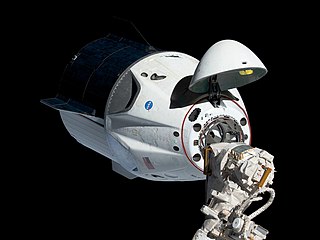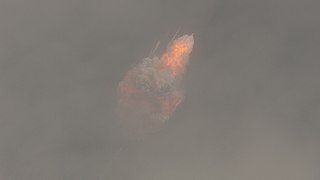Gallery
- Paracone Configuration
- Paracone Survival Pack
A paracone is a 1960s atmospheric reentry or spaceflight mission abort concept using an inflatable ballistic cone. [1] [2]
A notable feature of the paracone concept is that it facilitates an abort throughout the entire flight profile. [1]

MOOSE, originally an acronym for Man Out Of Space Easiest but later changed to the more professional-sounding Manned Orbital Operations Safety Equipment, was a proposed emergency "bail-out" system capable of bringing a single astronaut safely down from Earth orbit to the planet's surface.

STS-41-D was the 12th flight of NASA's Space Shuttle program, and the first mission of Space Shuttle Discovery. It was launched from Kennedy Space Center, Florida, on 30 August 1984, and landed at Edwards Air Force Base, California, on 5 September. Three commercial communications satellites were deployed into orbit during the six-day mission, and a number of scientific experiments were conducted.

The Apollo spacecraft was composed of three parts designed to accomplish the American Apollo program's goal of landing astronauts on the Moon by the end of the 1960s and returning them safely to Earth. The expendable (single-use) spacecraft consisted of a combined command and service module (CSM) and an Apollo Lunar Module (LM). Two additional components complemented the spacecraft stack for space vehicle assembly: a spacecraft–LM adapter (SLA) designed to shield the LM from the aerodynamic stress of launch and to connect the CSM to the Saturn launch vehicle and a launch escape system (LES) to carry the crew in the command module safely away from the launch vehicle in the event of a launch emergency.

Mercury-Redstone 1 (MR-1) was the first Mercury-Redstone uncrewed flight test in Project Mercury and the first attempt to launch a Mercury spacecraft with the Mercury-Redstone Launch Vehicle. Intended to be an uncrewed sub-orbital spaceflight, it was launched on November 21, 1960 from Cape Canaveral Air Force Station, Florida. The launch failed in a peculiar fashion which has been referred to as the "four-inch flight".

Pad Abort Test 2 was the follow-on second abort test to Pad Abort Test 1 of the Apollo spacecraft.

A-002 was the third abort test of the Apollo spacecraft.

A-003 was the fourth abort test of the Apollo spacecraft. This particular flight is notable because during the abort test flight, an actual abort situation occurred, and further proved the Apollo launch escape system (LES). The CM was successfully pulled away from the malfunctioning Little Joe booster and it landed safely under parachutes.

Little Joe II was an American rocket used from 1963 to 1966 for five uncrewed tests of the Apollo spacecraft launch escape system (LES), and to verify the performance of the command module parachute recovery system in abort mode. It was named after a similar rocket designed for the same function in Project Mercury. Launched from White Sands Missile Range in New Mexico, it was the smallest of four launch rockets used in the Apollo program.

A launch escape system (LES) or launch abort system (LAS) is a crew safety system connected to a space capsule, used to quickly separate the capsule from its launch vehicle rocket in case of a launch abort emergency, such as an impending explosion. The LES is typically controlled by a combination of automatic rocket failure detection, and a manual activation for the crew commander's use. The LES may be used while the launch vehicle is still on the launch pad, or during its ascent. Such systems are usually of two types:

Space Shuttle abort modes were procedures by which the nominal launch of the NASA Space Shuttle could be terminated. A pad abort occurred after ignition of the shuttle's main engines but prior to liftoff. An abort during ascent that would result in the orbiter returning to a runway or to a lower than planned orbit was called an "intact abort", while an abort in which the orbiter would be unable to reach a runway, or any abort involving the failure of more than one main engine, was called a "contingency abort". Crew bailout was still possible in some situations where the orbiter could not land on a runway.

A boilerplate spacecraft, also known as a mass simulator, is a nonfunctional craft or payload that is used to test various configurations and basic size, load, and handling characteristics of rocket launch vehicles. It is far less expensive to build multiple, full-scale, non-functional boilerplate spacecraft than it is to develop the full system. In this way, boilerplate spacecraft allow components and aspects of cutting-edge aerospace projects to be tested while detailed contracts for the final project are being negotiated. These tests may be used to develop procedures for mating a spacecraft to its launch vehicle, emergency access and egress, maintenance support activities, and various transportation processes.

The Orion Multi-Purpose Crew Vehicle is a class of partially reusable spacecraft used in NASA's human spaceflight programs. Consisting two components – a Crew Module (CM) manufactured by Lockheed Martin, and a European Service Module (ESM) manufactured by Airbus Defence and Space – the spacecraft are designed to support crewed exploration beyond low Earth orbit. Orion is equipped with solar power, an automated docking system, and glass cockpit interfaces modeled after those used in the Boeing 787 Dreamliner, and can support a crew of six up to 21 days undocked and up to six months docked. A single AJ10 engine provides the spacecraft's primary propulsion, while eight R-4D-11 engines and six pods of custom reaction control system engines developed by Airbus provide the spacecraft's secondary propulsion. Although compatible with other launch vehicles, Orion is primarily designed to launch atop a Space Launch System (SLS) rocket, with a tower launch escape system.
A pad abort test is a test of a launch escape system to determine how well the system could get the crew of a spacecraft to safety in an emergency on the launch pad.

The Max Launch Abort System (MLAS) was a proposed alternative to the Maxime Faget-invented "tractor" launch escape system (LES) that was planned for use by NASA for its Orion spacecraft in the event an Ares I malfunction during launch required an immediate abort.

Orion is a class of partially reusable space capsules to be used in NASA's human spaceflight programs. The spacecraft consists of a Crew Module (CM) designed by Lockheed Martin and the European Service Module (ESM) manufactured by Airbus Defence and Space. Capable of supporting a crew of six beyond low Earth orbit, Orion can last up to 21 days undocked and up to six months docked. It is equipped with solar panels, an automated docking system, and glass cockpit interfaces modeled after those used in the Boeing 787 Dreamliner. A single AJ10 engine provides the spacecraft's primary propulsion, while eight R-4D-11 engines, and six pods of custom reaction control system engines developed by Airbus, provide the spacecraft's secondary propulsion. Although compatible with other launch vehicles, Orion is primarily designed to launch atop a Space Launch System (SLS) rocket, with a tower launch escape system.

The SpaceX Dragon 2 is a class of reusable spacecraft developed and manufactured by American aerospace manufacturer SpaceX as the successor to Dragon 1, a reusable cargo spacecraft. There are two variants: Crew Dragon, a space capsule capable of ferrying up to seven astronauts, and Cargo Dragon, an updated replacement for the original Dragon spacecraft. The spacecraft launches atop a Falcon 9 Block 5 rocket and returns to Earth via an ocean splashdown. Unlike its predecessor, the spacecraft can autonomously dock to the International Space Station (ISS) instead of being berthed.

In the event of catastrophic failure, the Soyuz spacecraft has a series of automated and semi-automated abort modes to rescue the crew. The abort systems have been refined since the first manned flights and all abort scenarios for the Soyuz MS are expected to be survivable for the crew.

Crew Dragon In-Flight Abort Test was a test of the Crew Dragon abort system. The test was conducted on 19 January 2020. It involved the launch of a Falcon 9 from Launch Complex 39A on a suborbital trajectory, followed by an inflight abort of Crew Dragon at max Q. While the capsule successfully escaped, booster B1046 broke up due to aerodynamic forces, as expected.

The Crew Dragon Pad Abort Test was a spacecraft test conducted by SpaceX on 6 May 2015 from the Space Launch Complex 40 at Cape Canaveral Air Force Station, Florida. As part of the development of NASA's Commercial Crew Program, the test demonstrated the spacecraft's abort system capability, verifying the capsule's eight side-mounted SuperDraco thrusters' capability to quickly power itself away from a failing rocket while it is still on the ground. It was one of the two tests conducted by SpaceX on the abort system of spacecraft, the other one being the Crew Dragon In-Flight Abort Test conducted on 19 January 2020.

Crew Dragon C205 is a Crew Dragon capsule manufactured and built by SpaceX. It completed its first flight on January 19, 2020, with the Crew Dragon In-Flight Abort Test mission where the capsule detached from the Falcon 9 B1046 booster at max Q using the SuperDraco abort thrusters. This was done to test the functionality of the abort thrusters in an operational rocket launch.